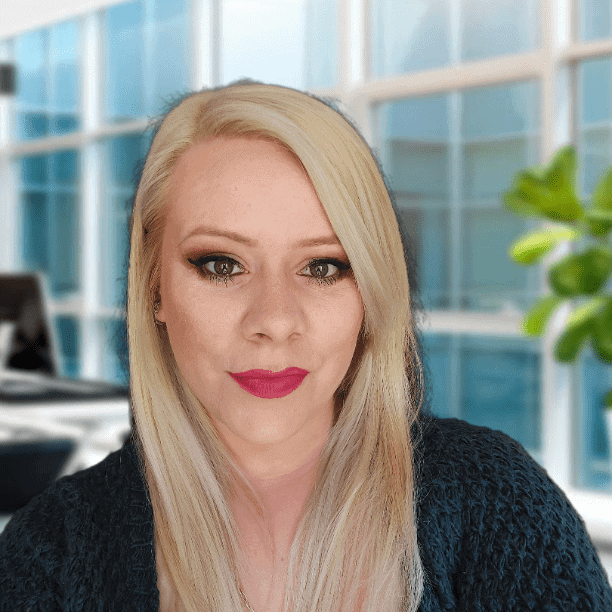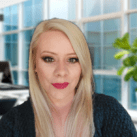
Tricia Carr, CCHt, BMSc, is not your typical spiritual guide—she’s a multidimensional channel, animal telepath, clinical hypnotherapist, and teacher of magic in its most authentic form. As a Spiritual Awakening Coach, Tricia helps people reconnect with their Higher Selves and open to a life filled with miracles, healing, and purpose. Through her courses, private sessions, and the beloved Charmed Life podcast, she serves as a transducer of divine frequencies—guiding clients to awaken their own exceptional human experiences. In this conversation, Mystic Mag explores how Tricia holds space for transformation, speaks with both spirits and animals, and lives her mission of helping others remember: life isn’t just magical—it is magic.
You say life is a working of magic—how do you define ‘magic’ in a way that is both mystical and actionable for the average person?
When I say that life is magical, I truly mean it. In fact, my podcast is called Charmed Life to encapsulate that very idea. Life, in and of itself, is a working of magic. Reality is both mystical and practical. This paradox—of holding the paradox—is a form of magic.
At its most fundamental level, magic is the transmutation of energy from one form into another. You could even say it’s the manipulation of energy, though some people have a negative association with the word manipulate. But that’s what we’re doing—it’s alchemy. And not just the old concept of alchemy as turning lead into gold. The ancient alchemists were actually working on shifting one form of energy into a preferred one—whether that was material or immaterial.
Another way to put it: you can turn fear into wisdom. You can transform longing, desire, or even a sense of lack into creation. Life is magical because we are constantly turning the non-material into material—and then, turning material back into the non-material. This is the process of ascension: spirit becoming human, and human ascending back into spirit.
Anyone can participate in magical workings simply by choosing their state of being. Whether through thought or by holding a certain frequency, you can witness how matter responds—or how you respond to matter and your environment. What naturally unfolds from that is magic in action.
This concept isn’t just abstract—it becomes very practical when viewed through the lens of modern science. Quantum physics, which is only about 100–120 years old, introduces the observer effect. The observer effect shows us that when we witness or observe a phenomenon, we actually impact it. Observation changes it, shifts it—it facilitates a form of participation. We shape reality with our observation.
That demonstrates that reality isn’t fixed—it responds to energy and consciousness. The only tool the observer uses to shape a phenomenon is consciousness. Observation and resonance are powerful. Another useful principle from quantum physics is superposition. It teaches us that multiple potentials can exist simultaneously. A 1 and a 0 can exist at the same time. We can attune to or “collapse” into one potential or another—again, through consciousness.
This is the essence of what I call consciousness technology: holding a state of being, awareness, and intention. Consciously constructing a belief allows energy to flow in a preferred way, turning it into lived experience.
Magic, including rituals and symbols, can help focus and harness conscious energy. But it’s not only about those tools. In my experience, we are all doing magic all the time—whether we realize it or not. That may make the idea less mystical to some, but to me, it makes it even more mystical: a communion between our consciousness and the morphogenetic fields.
We participate practically in magic by allowing ourselves to be the bridge between the unseen and the seen, between the pre-material and the material. We become co-creators with our consciousness instead of remaining passive or unconscious participants.
Every time you pause before reacting—every time you let your presence guide your experience—you are practicing magic. You are performing alchemy. And because we exist within a whole, closed system, our magic becomes more powerful when we hold the awareness that our intentions are for the highest benefit of ourselves and all involved.
When we view ourselves—or others—from a place of lack, the system self-corrects, and the magic becomes less effective. So yes, life itself is a working of magic.
Pause, observe, and then move forward. That’s the rhythm. That’s the magic.
How do you help someone discern the difference between spiritual awakening and spiritual bypassing, especially in a world hungry for instant transformation?
Yes, this is very important. We seem to be in an age of both increased spiritual awakening and increased spiritual bypassing. There’s a growing paradox between true spiritual experience and a false sense of spirituality—one rooted in dogma, superstition, and surface-level practices.
And then there’s the issue of people marketing spiritual services or transformation. I do this too—so this isn’t about casting judgment. But in an industry charged with money and competition, there can be a perception that spiritual awakening is supposed to be some kind of instant, ongoing experience—that your problems simply disappear. But if our problems or challenges vanished completely, there would be no growth. There would be no real spiritual experience, because we wouldn’t actually be engaging with our human experience.
So, maintaining balance becomes essential. That balance requires a deep practice of self-honesty, self-inquiry, and presence. Presence is what allows us to be uncomfortable and unlearn something in the moment—so we can grow. Self-honesty and inquiry help us discover whether we are acting out of fear—because often, spiritual bypassing stems from a fear of confronting something in our lives, or something in our psyche that remains unexamined.
In my work, I talk about—and help clients and students with—balancing hermeneutical thinking and empirical thinking. Hermeneutical thinking involves making meaning of life—subjective, intuitive, philosophical. Empirical thinking, on the other hand, is evidence-based and observable.
We can’t lean too far in either direction. If we rely solely on evidence, waiting for something to be proven a million times before we trust it, then we may never fully express ourselves or experience growth. On the other hand, if we overuse meaning-making, we risk disconnecting from the shared human experience.
This is similar to the difference between morals and ethics. Morals are personal and subjective—intended to help us become better individuals. Ethics are the shared agreements that help us function collectively. Ethics are more empirical and external, while morals are more philosophical and internal. Feelings, too, are important—but they are not facts. They support us, but they’re fluid, always in motion.
All of this plays into the practice of self-inquiry, self-honesty, and presence. And how do we know when to use hermeneutical versus empirical thinking? It comes down to presence and honesty. Hermeneutical thinking helps us feel more vital and connected to ourselves and others. Empirical thinking helps us remain grounded, responsible, and available to others.
At the heart of it all is this question: Are we moving from fear, or from presence?
Spiritual bypassing can sometimes masquerade as clarity—or worse, certainty. A good question to ask ourselves is: Am I moving from fear or from presence?
Am I using a teaching—or even just a thought—that hasn’t been fully examined, as a form of escape? One that’s actually creating separation from others?
Often, spiritual bypassing results in isolation or detachment from others. Ask yourself: Am I clinging to this belief or behavior because growth is difficult? Do I have enough information?
And am I making too much meaning of things? (I’m using air quotes here.) When we overuse hermeneutical thinking, we risk slipping into anxiety or hyper-logical thinking. We lose touch with embodiment—with the actual lived experience.
Awakening requires self-inquiry and radical self-honesty.
That kind of honesty is deeply spiritual. It’s the core of it all: to know yourself, and to love yourself. That’s why the golden rule sits at the heart of every major religion: Love your neighbor as yourself. One interpretation of that principle is: you can only love your neighbor to the degree that you love yourself.
There’s also a danger in feeling like you’ve “arrived” spiritually—or in appearing awakened. True spiritual growth is deeply personal, just like morals. Being willing to grow, to evolve, even when that growth is slow or messy—that’s what matters. At the end of the day, it’s all still human.
Whenever we try to escape being human, we move away from spiritual growth.
So I hold space for both the mystical and the raw, messy humanity. What unites them is compassion and growth. As I said earlier, I believe that being human is, at least from what I understand right now, the most spiritual experience there is. Maybe that’s why my soul chose to come here.
True spiritual growth holds the paradox. It shows up for the full experience—meeting it with honesty, seeing whether it calls for meaning-making, practical action, or just neutrality.
What type of services do you offer?
Everything I offer flows through my own energetic field, or aura. My Human Design is a 5/1 profile, which really fits with the way I work. I operate as a multidimensional channel, which means I connect mediumistically with energies, beings, archetypes, and consciousnesses from what I refer to as beneficial dimensions. Some of these might be archetypal in nature, others feel distinctly conscious and individualized. Whether we can ever fully know if they’re “real” in the literal sense, what I can say is that these connections feel real, and the relationships that form are deeply supportive and transformative.
I’m a certified clinical hypnotherapist with expertise in mind-body psychology, and I also work as an animal communicator. These are some of the more formal aspects of my background, but everything I do blends intuition, energy work, and channeling. Each session, whether one-on-one or in a group format, is guided by what is most present and needed in that moment.
In private sessions, I offer multidimensional healing and guidance. These are intuitive sessions where I bring together various modalities like channeling, mediumship, counseling, and always some form of hypnosis. Most people don’t realize that meditation itself is a form of hypnosis. Even energy healing operates in a hypnotic space—it invites the subconscious and the body into alignment. I also use a form of parts work and energy healing I’ve developed called Quantum Resonance Energy Healing. It’s designed to work on a deep, vibrational level to support transformation. Human Design insights often come through as well, as they help frame the energetic patterns people are working with in a very grounded way.
I also offer Akashic Records sessions, which are very special to me. These sessions are co-created with the client, who is guided to prepare questions in advance. I help shape those questions so they’re framed in a way that allows the heart to open to the highest possible benefit. During the session, I channel the client’s Divine Council of Light—their Akashic Council. These beings often remain unnamed, though their energy shifts, and they speak with distinct tones and perspectives. What comes through is always loving, wise, and aligned. These readings aren’t just about past lives, though past and even future timelines may come up. The emphasis is always on what’s most useful and empowering for the client in the present moment.
Another offering that’s dear to me is animal communication. I connect telepathically with animals, both living and passed on. For animals in spirit, it’s more like mediumship, and for those still with us, it’s a beautiful exchange of emotional, mental, and energetic information. I often include energy healing in these sessions, which helps support both the animal and their human.
Beyond one-on-one work, I’m also a teacher, and I’d say more than half of what I do involves group facilitation. I lead courses and programs that support intuitive development, energy mastery, healing, and spiritual embodiment. Some people come to this work because they want to develop their gifts professionally. Others simply want to live as integrated intuitives—people who move through the world with a deep connection to their inner guidance, whether that’s for personal growth, a creative path, or a broader sense of spiritual mission.
The common thread in everything I do is helping people awaken and embody their true nature. Whether they’re receiving guidance through a private session, connecting with their spirit team, or learning to hear their own inner voice more clearly, the work is always about integration. It’s about bringing the unseen into the seen, and living in alignment with one’s authentic spiritual self—fully grounded in the human experience.
So, in the end, the services may vary, but the essence is the same: facilitating healing, insight, and transformation, guided by presence, love, and a deep respect for each person’s unique journey.
Your mission is to help others walk the path of light—what does it mean, practically and spiritually, to “walk the path of light” in today’s complex world?
Let’s begin with the idea of light. In many spiritual traditions, light represents awareness. When we think of light, particularly in a spiritual context, we often associate it with qualities like purity, inspiration, and a sense of wholeness or unity. People also commonly equate light with concepts like God, Source Energy, or the Divine—and at the root of all of those ideas is really just another way of saying conscious awareness.
So, to walk a path of light is to walk with mindfulness and intention. It’s to move through life guided by deep presence. Imagine that with each step, you are laying down a path—like Michael Jackson in the “Billie Jean” video, where every step lights up beneath him. That’s what it’s like when you’re present: your awareness illuminates the path before you. Each footfall lights up the ground ahead, creating a current, a frequency that moves you forward. And when your heart is guiding you, it feels as though the path was already there, waiting to be walked. Still, you must be present to activate it.
I believe this kind of conscious path is available to everyone. And in today’s complex world, our awareness is more essential than ever. Complexity doesn’t mean we’re lost—it just means we need more presence, more mindfulness, more light. If we feel overwhelmed or thrown off balance, it’s an invitation to return to awareness, not to abandon it.
Part of our challenge is that we are biologically conditioned to focus on the negative. The human psyche, especially the ego, operates with a negative bias. Our primitive, survival-oriented mind is constantly scanning for danger. It wants to focus our awareness on threats—real or imagined—as if doing so will prevent harm. But ironically, constantly fixating on the negative, especially on things from the past or future that don’t actually exist in the present moment, robs us of our vital energy. It arrests our awareness, leaving it trapped in loops of fear, rather than allowing it to flow freely as a source of power.
There’s a common misconception that being hyper-alert to danger makes us smarter or more capable. But the opposite is true. We are more intelligent, more emotionally resilient, and more capable of problem-solving when our awareness is calm and grounded. Neuroscience and psychology both support this: calm presence leads to better cognitive function.
Yet we live in a world that constantly triggers fight-or-flight responses—and most of the time, we’re not actually in life-or-death situations. For instance, during an ordinary day, I might find myself slipping into a state of mild stress or anxiety, but I’m not actually fighting or fleeing for my life. The hormones released in a true fight-or-flight moment—like adrenaline and cortisol—are meant to complete a full cycle. If they don’t, and we stay stuck in a low-grade, ongoing stress state, those hormones linger in the body and become toxic over time.
If you’ve ever experienced a near-miss car accident or another intense situation, you may recall that after the peak of the event, you entered an oddly calm, clear state. That’s the body moving into a deeper level of presence, completing the stress cycle and moving into focus, sometimes even serenity. But in our modern world, we rarely allow that full process to unfold. We stay trapped in the middle, in a kind of limbo state—chronically stressed, but not moving through it. This keeps our awareness frozen, rather than flowing.
And this brings me back to the path of light. In a world that invites chronic distraction and stress, reclaiming your awareness—your light—is a powerful act. When you light your path with presence, you inevitably illuminate the paths around you. Your awareness doesn’t just serve you—it creates a ripple effect in the energy field you share with others. In a reality where everything is interconnected, your light contributes to the balance and coherence of the whole.
So yes, walking the path of light is both mystical and practical. And I think that’s where I most enjoy living—in that liminal space where the mystical and the practical meet. That’s where the magic happens. Not in escape, but in conscious embodiment. In walking with the awareness that every step matters, and that presence—true presence—is the light that guides the way.
You emphasize that spiritual abilities are available to everyone—what are a few signs that someone’s intuitive or magical abilities are beginning to awaken?
The awakening experience is deeply individual. It looks different for everyone. While I could list common signs, I think it’s more meaningful to share how it unfolded for me personally.
As a child, I had what people call “imaginary friends,” though neither I nor my family saw this as anything spiritual or unusual. It wasn’t framed as mediumship or intuitive ability—it was just part of childhood. Later in life, after what I now consider a spiritual awakening, I began to understand those early experiences differently. My awakening wasn’t about suddenly gaining something I didn’t have. It was about finally saying yes to something that had always been there.
To me, awakening means realizing that we are multidimensional beings. It’s not about discovering something “out there”; it’s about recognizing what’s already within and around us. It’s like suddenly realizing you can draw—you always could, but you finally gave yourself permission to try. That’s what it was like for me.
Looking back, I now see that I always had moments of prescience—I would say something, and people would ask, “How did you know that? I never told you.” I’d insist they had told me, because I knew it, but in reality, I was picking up information intuitively. I didn’t recognize it as psychic ability. I thought I just had a good memory, or that I was “weird.” But it wasn’t until I began to trust myself more deeply that I started to see what was really happening.
I was part of a religion in my youth and early adulthood, and I did have mystical experiences during that time. But because of the structure of religion, I was able to explain those moments away, to fit them into accepted frameworks. It wasn’t until I began doing interpersonal healing—learning to trust myself, accept myself, and listen to my inner truth—that I became more open to what was already active within me.
Eventually, I began waking up in the morning with thoughts and feelings that didn’t feel like they belonged to me. They weren’t rooted in my current life experience—they made no sense. That stirred my curiosity, and I decided to book a session with a psychic, just for fun. I told myself my mind was strong enough to handle whatever came up, even if it felt strange or even scary. That playful curiosity, grounded in self-trust, became the doorway.
There’s a quote by Neville Goddard that resonates with me: “Signs follow—they do not precede.” In other words, when we shift internally—when we step into self-trust and sovereignty—signs and synchronicities begin to appear in response to that shift. It’s not the signs that cause the awakening; it’s the awakening that causes the signs to appear.
In my case, I didn’t have dramatic external signs right away. Instead, I noticed that some of my thoughts and feelings didn’t originate from me. They weren’t mine, and yet they were in my awareness. That recognition was subtle but profound. As I continued to tune in, things began to accelerate.
Other people often report more visible signs: vivid dreams, symbolic or instructional messages while sleeping, lucid dreaming, or what they later realize were astral projections. People start noticing repeating numbers, or feeling more emotionally sensitive and empathetic. Sometimes, it’s simply an increasing sense of connection to others—a sense of being more present, more embodied, more attuned to what feels right for them.
And something really interesting happens: the conversations around you begin to change. Suddenly, people in your life—whether new or longstanding—start talking about spiritual topics, intuitive gifts, or mystical experiences. These conversations seem to find you. It’s like the world around you is rearranging itself to match your inner frequency. Those synchronicities are the signs that you’re ready—not just to receive information, but to begin using your abilities for yourself and potentially for others.
So, while spiritual awakening may look different for everyone, at its core, it’s a return to self-trust, presence, and recognition of your multidimensional nature. The signs don’t awaken you—you awaken, and the signs follow.



